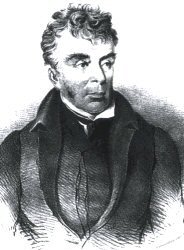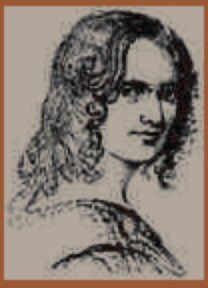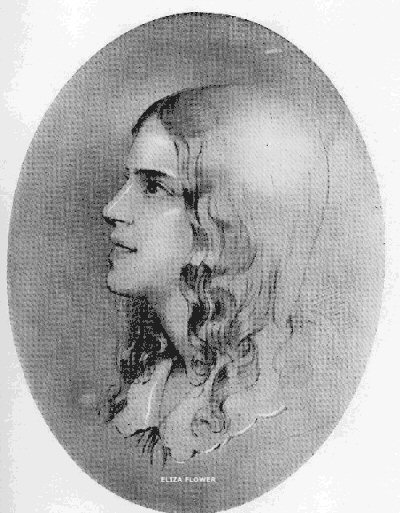
Two
Letters to John Fowler

John Fowler was a great friend of the Corn Law Rhymer.
He was a Sheffield man born in 1783 at Wincobank, then a small village. He was
a professional man who did well in life reaching the grand age of 89 before
passing away in 1872. He was well-known in Sheffield, but he was noted for
being the father of Sir John Fowler of the Forth Road Bridge fame.
The two letters are worth recording since they both
give an insight into the life of Elliott and into his friendship with John
Fowler. Elliott drawing shown on the right.
The
1841 letter
This
amusing letter, written in 1841, was found in the Special Collections Research
Center of the University of Kentucky. (identifier 1997ms474). Thanks to the
university for giving permission to use the manuscript.
1841
was a significant year for the poet, as he left the excitement of Sheffield for
health reasons and move to a rural location near Barnsley. He was so busy with
his new house and garden that he had no time for writing poems; something which
made 1841 an unique year in Elliott’s life.
The
letter was written on the 24th of February, only a month after the
Corn Law Rhymer had moved to his new home near Great Houghton. It is
interesting that the letter was actually written from Sheffield. From this we
can deduce that Elliot was staying the night with his children either tying up
loose ends at his old villa in Upperthorpe or attending a function in Sheffield
after which it would be too late to travel back to the wilds of Greateat Houghton.
The
tone of the letter is informal, even flippant, something which makes it unique
in the bard’s correspondence. John
Fowler (1783 – 1872) was a dear friend and was a member of the Elliot Club as Ebenezer's
admirers like to call themselves. More information about John Fowler is available in “Friends and Acquaintances
of the Corn Law Rhymer” in the Ebenezer Research Foundry, which is a list of
research articles about the poet.
Elliott’s
letter was simply addressed to John Fowler implying that it was delivered by
hand. The text of the letter is given below.
DSir Sheffield 24th
Feby 1841 Now
show yourself a man- and a cricket. Write a critique on Vivia Perpetua by Sarah
Flower Adams, Lizzie’s sister – call it A Lecture On The Modern Drama- and
spout it to the wisest of mortals, in our holy Chapel of Radicalism. Perhaps
Tait would accept it- and you might spout it afterwards. I
would give my ears (and you know they are long ones) to be the author of the
last two acts of this play- they are really fine; And there are some pathetic
passages towards the close. Sarah can draw characters. I
am DSir yours very truly Ebenezer
Elliott
The
first line of the letter “Now show yourself a man- and a cricket” indicates
that the two friends liked to joke about the words “critic” and “cricket” which
sound very similar. The first part of the line is Elliott teasing Fowler by
suggesting it was high time to make a name for himself by writing a study of
“Vivia Perpetua.”
Sarah Fuller Flower Adams (1805-48) wrote “Vivia Perpetua” early in the same year as Elliott’s letter. From this, we conclude that both Elliott and Fowler had only just read the work which was published sometime between January 1st and February 24th- the date of the letter. The two men were clearly on the ball since “Vivia Perpetua” could only have been published a week or so before the letter was written.

“Vivia
Perpetua” was a dramatic poem in five acts and was inspired by a heathen who
had converted to Christianity. Religion was very important to Sarah; like
Elliott, she was an Unitarian and a poet so the two had much in common. Sarah
also wrote hymns, the most famous being “Nearer My God To Thee.”
Elliot’s letter call Sarah “Lizzie’s sister.” This Lizzie was Eliza Flower (1803-46), a talented composer and musician. The bard was an admirer and acquaintance of Eliza as can be seen by him familiarly calling her Lizzie. Using the name Lizzie to Fowler implies that the latter also was acquainted with Eliza. More about Eliza can be found in the article “Radical Friends – Eliza Flower and Rev Fox” in the Ebenezer Research Foundry.

Eliza Flower
The Poet of
the Poor used the word “spout” twice in his
letter. Elliott was encouraging his friend to give a lecture on “Vivia
Perpetua”
but because a lecture implies a scholarly approach, Elliott
deliberately
downplays this to make lecturing sound informal and fun! Elliott was of
course
used to public speaking and giving lectures, but Fowler may not have
the skills
of the poet. Elliott felt that his friend needed some encouragement.
“Our
holy Chapel of Radicalism” is Elliott’s amusing name for the Sheffield
Mechanics’ Institute, while he is being sarcastic in describing the members as
“the wisest of mortals.” Elliot and Fowler were officials of the institute and
Elliott had often given lectures there, so he had an intimate knowledge of the
institute and its members. It would be a good place for Fowler to make his name
as a lecturer.
Many
poems and articles by the Corn Law Rhymer had appeared in the Scottish journal
called Tait's Edinburgh Magazine. By suggesting Fowler’s article “Lecture On The
Modern Drama” might be submitted to Tait for publication, Elliott is again
trying to boost his friend’s self-confidence.
The
concluding paragraph of the letter is interesting. The statement “I would give my ears (and you
know they are long ones)” shows Elliott being light hearted again, something
rarely seen in the Rabble's Poet. He is envious of Sarah’s skill in characterization
and her use of pathos. Elliott had attempted to write drama but was not
successful which explains his admiration for “Vivia Perpetua.”
The
1849 letter
Another
letter from Elliott to Fowler is dated Nov 1st 1849. The letter
is worth reading since it gives a
further insight into the relationship between the two men. It also tells how
busy Elliott was with his literary endeavours even at this late time in his
life.
Following
a request from the compiler of these webpages, the letter was purchased for
£150 in 2005 by The Friends of Rotherham Archives in memory of Tony Munford,
the Rotherham historian & former archivist, who died in 2004.
Dated
1st Nov 1849, the letter was probably the last letter written by the
poet who died exactly four weeks after writing the letter. Elliott was always
fascinated by his health problems, but ironically stated in the letter that he
thought he was on the mend. Clearly the letter was written on a good day – the
neat & tidy handwriting would support this notion. (Some of the letters
from this period show a large clumsy hand prone to making mistakes).
The
letter, posted at Barnsley with a penny red stamp, was addressed to Elliott’s
great friend: -
John
Fowler Esq
Occupation
Road
Sheffield
Fowler
had often dined at Elliott’s house in Upperthorpe, Sheffield, and was treated
as one of the family; which showed how much Elliott valued the friendship with
Fowler since family was extremely important to “the bard of the rabble” as
Elliott called himself. In fact, he once described Fowler as “our son by better
ties than blood.” A strange remark really, as there was only two years between
them.
Both
men were deeply involved with the Sheffield Mechanic’s Institute: Fowler was
Secretary & Elliott Vice President. Yet there must have been other
connections for their friendship to be so deep; both shared a passion for
literature, for instance, but most likely they were of one mind when it came to
reforming the Corn Laws.
Elliott’s poem “The Gipsy” was dedicated
to Fowler opening with the following lines:-
John Fowler, I owe you a tale
or a song,
I’ve remain’d, I confess it, your
debtor too long;
So, painting in verse and rude
Saxon, a scene
Where oft with the bard of the
rabble you’ve been,
I daub on the landscape a figure
or two,
Not portraits from life, but
ideally true,
And humbly inscribe the poor
picture to you.
The poem is set in Stannington, a village
near Sheffield, and line 4 indicates that both Elliott & Fowler knew it
well. This relates to the bard’s habit of taking his friends on long walks
while discussing the hot topics of the day.
The
letter to Fowler (see below) shows Elliott writing cogently which contrasts
with some of his letters of this period which are dimmed by using laudanum.
Note, too, his compliments about female gifts at literary appreciation.
DSir
--------- Hargate Hill nr
Barnesley 1 Nov 1849 Many thanks for all your kindness. I
cannot possibly attend your soiree. The last time I was at Sheffield, my
principal business was to see Dr Thompson, but my disease would not allow me to
wait his hour, and I returned without seeing him. At last, however, I think
I see my way towards recovery; & if I should be sufficiently well, I
will try to see the great Tragedian. At the suggestion of the author of Festus,
I have revised “Taurassdes,” & I almost think it would now act. In my
forthcoming volume “More Verse And Prose By The Corn Law Rhymer,” will appear
“Etheline.” The first part of “Eth-Kon-Tel” an Epic poem in 12 books. It
consists of three parts, all forming one narrative, but each part complete in
itself. The locality is Conisbro, and the time about 400 years before Christ.
When it appears, I hope to be honoured with your opinion of it. Mrs Fowler, I
hope, will tell you what she thinks of it; for I have found that the ladies are
usually right in their critical judgements.
I
am, DSir, Yours very truly,
Ebenezer
Elliott
Dive in to Elliott's poetry pages
Bash the anvil to go to the Ebenezer Research Foundry 